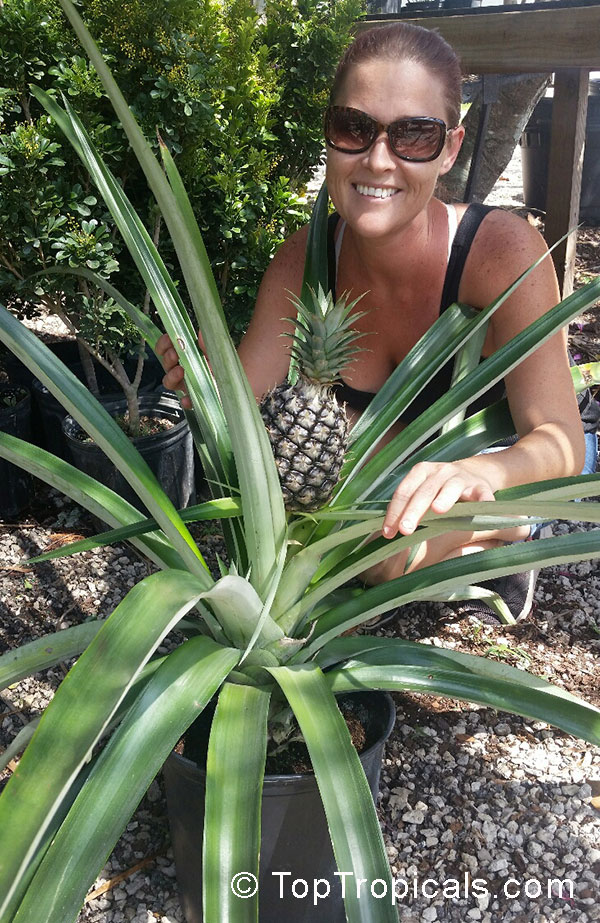PINEAPPLE FRUIT PLANT WHITE JADE (ELEUTHERA), SPINELESS SWEET (ANANAS SP.)
3934 Pineapple fruit plant White Jade (Eleuthera), Spineless Sweet (Ananas sp.)







Super sweet and low acid: White Jade has tender white flesh that's ultra-sweet with almost no acidity. The flavor is smooth and rich, far better than anything you'll find in a grocery store.
Edible core: The core is soft, juicy, and 100% edible - no waste and no tough center.
Spineless leaves: Unlike most pineapples, White Jade has soft, spineless leaves, making it much easier and safer to handle.
Compact and container-friendly: It stays small, perfect for pots, patios, or tight garden spaces.
Backyard hero, not for shipping: This variety bruises easily, so it's rarely seen in stores - but perfect for home gardeners who want top-tier taste.
Tropical beauty + fast fruiting: With its blue-green foliage and striking fruit, it's ornamental as well as productive. Expect fruit in as little as 18-24 months with good care.
Although often mistaken as a Hawaiian variety, White Jade actually originated in Eleuthera, Bahamas. It thrives in warm climates and rewards gardeners with a sweet, low-acid treat unlike any commercial pineapple. It is grown in Hawaii now, especially by backyard gardeners and small farms, because it does so well there.
Read more about Pineapple: The most luscious Hospitality Fruit: Pineapple.
Recommended Fertilizer: SUNSHINE Ananas - Pineapple and Bromeliad Booster
SUNSHINE-Honey - sugar booster
SUNSHINE-Superfood - micro-element booster
Pineapple fruit plant White Jade (Eleuthera), Spineless Sweet (Ananas sp.): Planting and Care Instructions
Plant Overview
Growth habit: This is a small herbaceous plant, growing between 2 and 5 feet. It is great for flower beds, pots, or small garden spots.
Growing conditions: This plant can be grown outdoors in suitable USDA zones. It is well-suited for small backyards, pots, or indoor spaces with enough light.
Watering: This plant needs moderate watering. Allow the top of the soil to dry slightly before watering again.
Sun exposure: This plant grows well in both full sun and semi-shade. If kept indoors, give it as much light as possible for best growth.
USDA Zone: USDA 9-11. The USDA Plant Hardiness Zone Map categorizes North America into zones based on average annual minimum winter temperatures, each differing by 10 °F. This map serves as a basic guide for selecting appropriate plants for a region. However, it's not definitive; plant varieties vary in cold tolerance, and young plants typically need more protection. Additionally, local microclimates, like sheltered areas or sunny spots, can influence plant health and survivability beyond the general zone recommendation.
Cold Hardiness: Tolerates light freezing to about 30°F for short periods (mature plants). Young plants must be protected. Plant hardiness indicates the coldest temperature a mature plant can endure briefly while staying healthy. This rating is a guideline and can vary among varieties of the same species. Young plants often need more cold protection. Additionally, a plant's survival can be enhanced by the microclimate of its location, which may provide shelter from wind or extra warmth, allowing it to thrive beyond its typical hardiness range.
Plant type: This is a fruit tree (Pineapple, Ananas). With proper care, it produces edible fruits.
Thorns: This is a thorny or spiny plant. Use gloves when handling or placing it in the garden.
Outdoor planting
Select a planting spot that fits the plant sun and moisture needs. Loosen the soil and mix in compost or organic matter to improve poor soil. Dig a hole just slightly larger than the root ball and avoid planting deeper than it was before. For better drainage, the top of the root ball can sit slightly above the surrounding soil. Provide temporary shade at first if conditions are hot or sunny. Water regularly and monitor soil moisture until the plant is well rooted. nAdd mulch around the base to keep the soil moist and reduce weeds. Shape the mulch to form a shallow basin for water, but keep mulch away from the stem.
Indoor planting
Use a container with drainage holes and a well-draining potting mix. Position the plant so that the top of the root ball is level with the surface of the soil - avoid planting too deep. A slow-release fertilizer can be mixed into the soil at planting time to support healthy growth. Place the plant in a location that matches its light needs, and water according to its care requirements. Be careful not to overwater, and ensure good airflow around the plant to reduce the risk of pests and disease.
Protecting Plants in Winter
When it gets cold, some plants need extra help. You can move potted plants indoors or under a covered patio. Young plants need extra protection because they are more sensitive to cold and less established. For plants in the ground, use frost cloth to keep them warm. Stop using fertilizer in late fall so plants can rest. Try to place plants in areas protected from cold wind, rain, and frost.
Cold Hardiness and Microclimates
USDA zone and hardiness are only general guidelines. Actual cold tolerance can vary based on plant variety and local conditions. Even small differences between varieties can matter. Also, warmer spots in your yard—like near a wall or fence—can help plants survive cold nights. These little warm areas are called microclimates, and they make a big difference.
